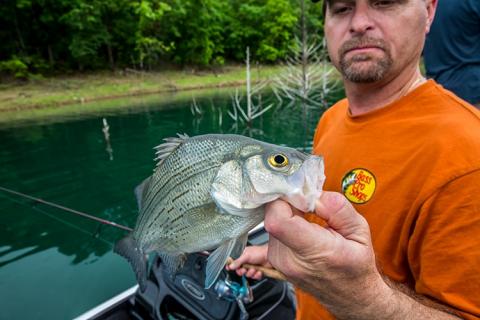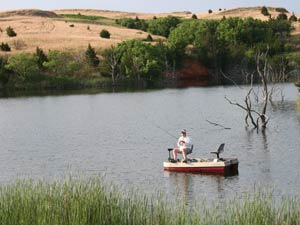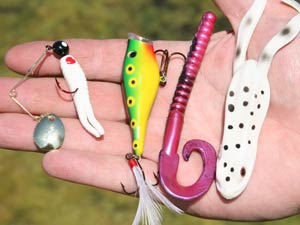
Ponds and small lakes don't just harbor little bass. Many also hold some giants, and these fish get that way because most anglers focus their efforts on larger, more renowned waters.
These waters may be pint-sized, but their rewards can be grand for those who realize their potential and take pond fishing to a higher level. Here is how to get in on one of one of the best, most available yet least recognized opportunities in the world of Micropterus salmoides.
Locating Fishable Farm Ponds
 |
| Ponds and conservation lakes can offer fantastic bass fishing for anglers who go to the effort to locate them. |
The old adage about finding farm ponds has been written numerous times: "Drive along country roads, and watch for good-looking ponds. When you find one, knock on the farmer's door, and courteously ask his permission to fish it. If he says yes, leave a light footprint and make sure to close all gates behind you to keep his cows in." Blah, blah, blah.
Get real! Serious fishing calls for serious effort. This first part of the pond fishing equation requires an all-out assault. Yes, drive back roads and knock on farmer's doors. Sometimes this approach works. But modern pond detectives have the tools to conduct a far broader, more comprehensive search.
For instance, use the Internet. Log onto Google Earth and zoom in on your target area. Look for ponds that are tucked back away from roads. Nobody sees these while driving around, and landowners are less likely to have been approached by strangers wanting to fish. Thus, they might be more prone to say "yes". (Some states publish plat maps with landowners' names — a huge help in making contact to ask fishing permission.)
Check about pond locations with any possible human info sources: mailmen, school bus drivers, game wardens, farm service agents, Co-op workers (especially the ones who make fuel deliveries to farmers), etc.
When you get a lead, don't be shy about pursuing it. Asking permission is like selling insurance. Persistence pays! Some landowners will surely say no. But it only takes one or two who say yes to provide for some great fishing.
Don't expect good fishing ponds to fall in your lap. You have to work to find them. Keep searching. Develop a repertoire of good spots, and don't fish any one pond too often. Also, be utterly respectful of the farmer's property and the opportunity he's given you to enjoy it. Don't leave any trace of your visit behind (empty lure packs, gum wrappers, discarded line, etc.). And oh yeah, don't forget to close the gates behind you to keep the farmer's cows in.
Pond Fishing Lures, Tackle, Techniques
I once shared an afternoon of fishing on the Chain Ranch with Eric Naig of Northland Fishing Tackle. Naig is a pond-fishing expert. He grew up fishing for bass in ponds in his native Iowa, and he continues to focus on smaller waters today. His approach to fishing small waters is simple, yet extremely effective.
"Patterning pond bass is a lot easier than patterning fish in big reservoirs or natural lakes," Naig begins. "There's less water to cover, so you can test your options faster. Also, ponds are easier to 'read' to find the prime spots where bass should be holding. If you know what you're doing, it should take only a little while to piece the puzzle together."
 |
| Fishing lures and baits like weedless frogs, plastic worms, topwater baits and spinnerbaits are four dependable lure choices for catching big bass from ponds and conservation lakes. |
For starters, Naig uses a seasonal approach to pond fishing. "In spring and fall, I'll begin by working the shallow end, away from the dam. But in summer or winter, the bass will be deeper, so I'll start on the dam end of the pond."
Next, Naig analyzes the lay of the pond, including available cover. "Many times there's not much structure away from the bank, so I'll focus on any visible cover, especially weeds and brush around the shoreline. I'll pay special attention to points, submerged weedlines (visible in clear water), a brush-lined ditch or other prominent features."
In so doing, Naig relies on a few simple yet dependable lures: spinnerbaits, topwater poppers and frogs, sink worms, Texas-rigged Gulp worms, shallow crankbaits, and jigs/plastic trailers. He fishes all these on the same tackle he uses on bigger waters. "You don't have to be as 'finessy' in ponds as you may need to be in heavily-fished lakes and reservoirs," he explains. "Because of the lack of fishing pressure, pond bass are more naive than big water bass, and you can get away with using heavier tackle."
(Naig spools up with 12- to 14-pound test Berkley Trilene 100% Fluorocarbon line for most presentations. He prefers heavier Berkley Fireline Braid when working topwater frogs around thick vegetation and woody cover.)
When fishing around the banks, Naig casts as close to parallel as he can to shoreline cover, retrieving his lure along the face of reeds or brush. "This keeps the bait in the strike zone longer," he explains. "It's a lot faster, more efficient way to cover water and contact bank-holding fish."
He continues, "If I don't get much action around the banks, then I'll start working deeper. I like to use a heavy Carolina rig to see what's out there. I'll random-cast places where a gully may run out or a point extends off the bank. I'll fish any structure or cover object that I can find."
Naig explains that he moves around a pond quickly, picking off active fish. Then he slows down and returns to the more productive or best looking areas to fish them more thoroughly. He also experiments with different lures/presentations to see which the bass prefer on that given day. For instance, if he caught fish along one stretch on a spinnerbait or a crankbait, he may work the same zone with a worm to coax more strikes from hesitant biters.
"The main deal in pond fishing is to be able to pick out the best spots and to work them without spooking the fish by making too much noise or commotion," Naig summarizes. "Look for cover. Look for bank structure that runs out under the water. Look for wind-blown banks. Just move around a pond quickly to test your options, then go back and concentrate on the area and pattern that's working the best."
Fishing From a Bank or Boat?
Another choice pond fishermen have to make is whether to fish from the bank or from a small boat. Eric Naig says, "Each of these options has its strong points. Bank fishermen can be very quiet, and they can slip up close to bass holding next to a weed line or a log.
On the other hand, boat fishermen can cover a pond faster and more thoroughly, and they can fish bigger ponds. Also, they can rig their boats with such conveniences as a trolling motor, tackle containers, cooler and even a portable fish finder."
A good pond-fishing boat is portable (can be launched/loaded on undeveloped pond banks); stable enough for one or two anglers to fish comfortably; and quiet enough to avoid alerting fish to anglers' presence. Good examples are a pontoon boat, a small metal jon boat, a canoe and a float tube.
Summary
During my excursions with Andrew Wheeler and Eric Naig, the Chain Ranch's ponds provided us with dozens of bass, including many in the 3 to 5 pound range. Once I had a 4-pounder launch itself out of the water like a porpoise and crash down on my popper. Looking back, I can't imagine enjoying faster action or greater thrills on any reservoir in the country.
And this can be the norm when pond fishing. Search out the good spots. Use basic tactics for naive bass, and relish the pleasures that this combination brings. Indeed, taking pond fishing to a higher level is actually stepping back to simpler fishing. At least the methods are simpler. The action is what makes pond fishing a cut above.
- 15091 views

